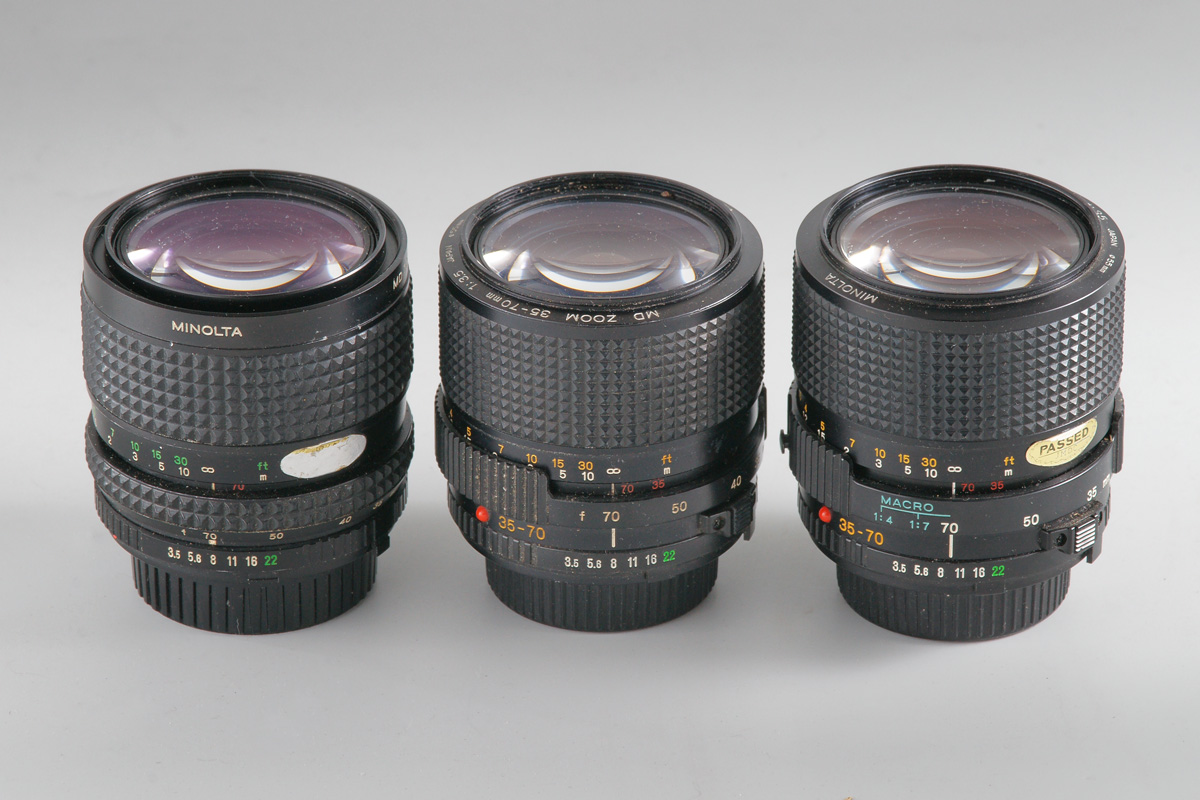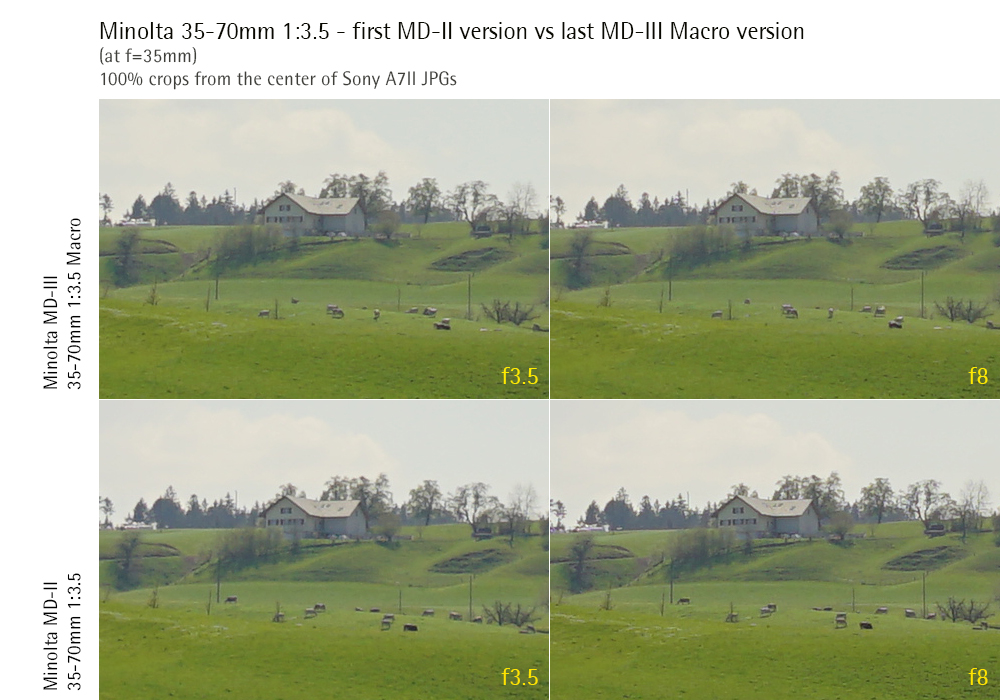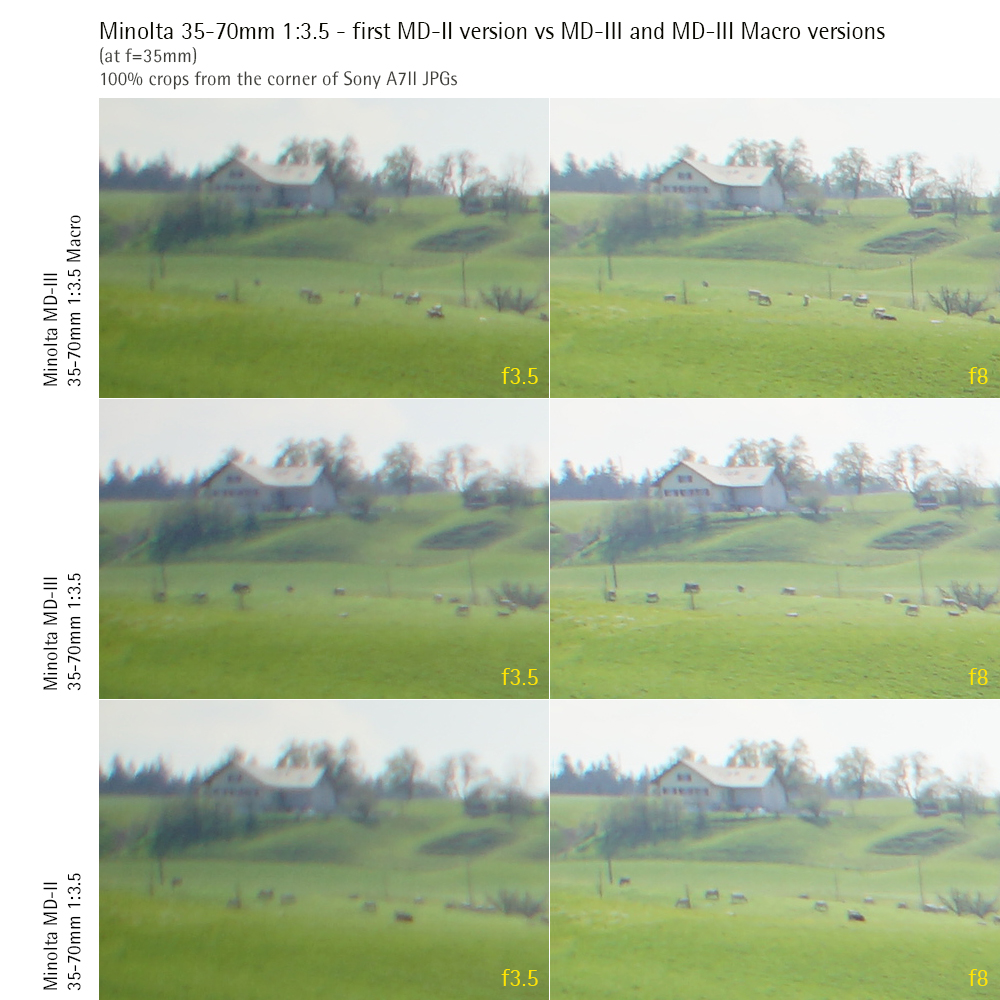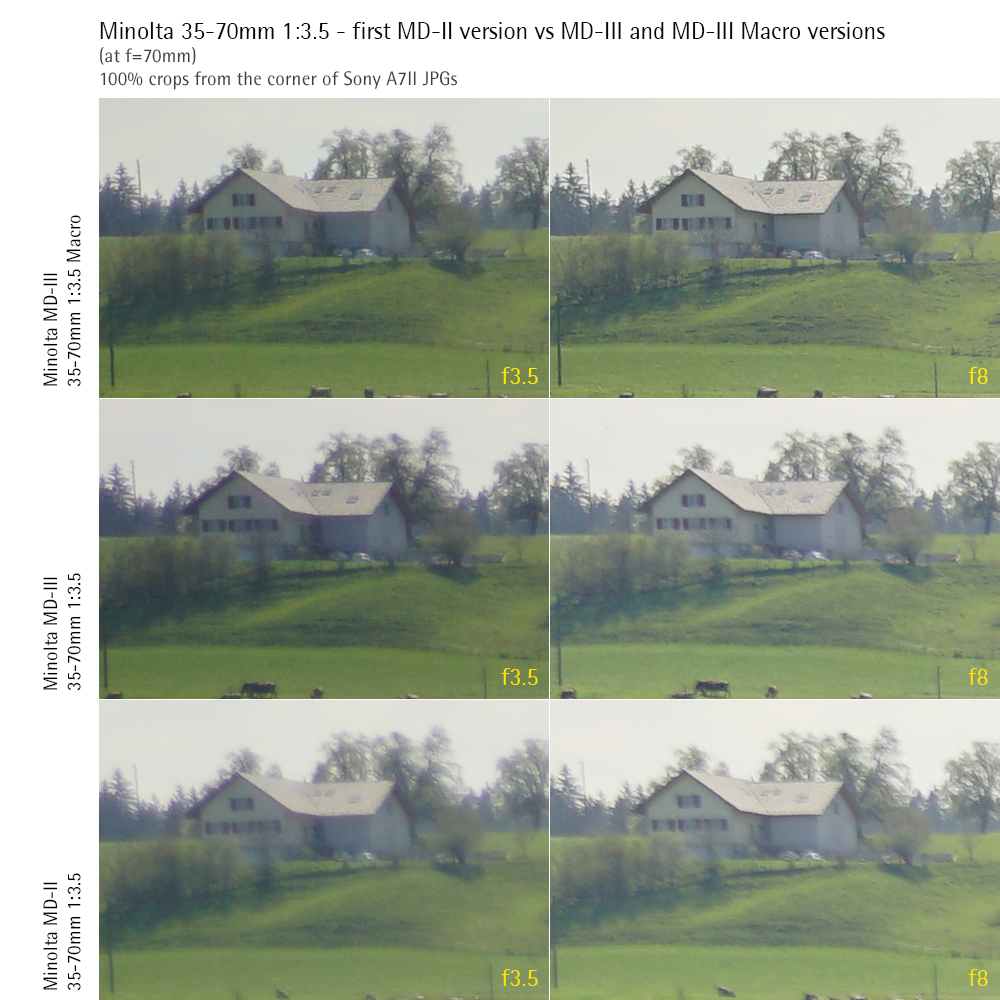| View previous topic :: View next topic |
| Author |
Message |
stevemark

Joined: 29 Apr 2011
Posts: 4079
Location: Switzerland
|
 Posted: Sun Apr 25, 2021 1:51 pm Post subject: Minolta MD 3.5/35.70mm: Comparing the three versions Posted: Sun Apr 25, 2021 1:51 pm Post subject: Minolta MD 3.5/35.70mm: Comparing the three versions |
 |
|
stevemark wrote:
There are three versions of the Minolta MD 3.5/35-70mm:

1) MD Zoom Rokkor 35-70mm 1:3.5 (aka "MD-II", left)
2) MD Zoom 35-70mm 1:3.5 (aka "MD-III", middle), without macro function
3) MD Zoom 35-70mm 1:3.5 (aka "MD-III", right), with macro function
The barrel of the first two versions is slightly shorter than the barrel of the third version, indicating that the Macro version has a slightly different optical computation. From my testing, however, the two MD-III versions seem to perform nearly identically. The MD-II version, however, is inferior (mainly at f=70mm; not much diference at f=35mm).
When it comes to center resolution on 24MP full frame, the versions give identical results - be it wide open or at f8 (which is probably the optimal aperture):

At f=35mm and looking at the corners, there's not much difference between the three versions. The MD-II seems to be slightly softer, though:

At f=70mm, and again looking at the corners, we can see a steady improvement from the first to the last version:

It's obvious that the last MD-III Macro version is quite a bit better than the MD-II version. I have done these tests with a total number of 12 lenses (two MD-II, five MD-III, and five MD-III Macro). I'm too lazy tro publish all of them - and nobody would look at them anyway. However I can say that there's remarkably little variation between samples of the same version, and quality control at Minolta seems to have been quite good. Mamiya, for example, had much more sample variation when I was testing ten of their Sekor E 3.5/135mm lenses some years ago.
S
_________________
www.artaphot.ch |
|
| Back to top |
|
 |
Antoine

Joined: 08 Jan 2016
Posts: 298
Location: London
|
 Posted: Sun Apr 25, 2021 3:58 pm Post subject: Posted: Sun Apr 25, 2021 3:58 pm Post subject: |
 |
|
Antoine wrote:
Thanks 
_________________
Antoine
Sony A6000 APS-C and Sony A7 Rii
Minolta Fisheye MD Rokkor 7.5 mm f4, Fisheye MD 16 f2.8 MD R 17mm f4, MD R 20mm f2.8, MC VFC & MDIII 24mm f2.8, MD 28mm f2.0 &3.5, MD II 35mm 1.8, MD 45mm f2.0, MD 50mm f 1.2 & MD I f1.4, MC PG 58mm 1.2, MD 85mm f2.0, MD R 85mm f2.8 Varisoft, MC 85mm f1.7 MD R 100mm f2.5, MD R 100mm f4.0 macro, MD III 135mm f2.8, MD R 200mm f2.8 & 4.0, RF 250mm f5.6, MD 300mm f4.5, MD APO 400 mm f5.6, RF 500mm f8.0, RF 800mm f8.0 *2 300-s and 300-l
100 mm f4 macro bellows (5/4)
Vivitar 17mm f3.5, Elicar 300mm mirror f5.6, Zhongi turbo ii
Sigma 16mm f 2.8 fish eye
Zooms:24-50 mm f4, 35-70 mm f3.5 macro, 28-85mm f3.5-4.5, 50-135 f 3.5, 70-210 f4 and MD APO 100-500 mm f8 |
|
| Back to top |
|
 |
lumens pixel

Joined: 27 Feb 2019
Posts: 887
Expire: 2021-06-25
|
 Posted: Sun Apr 25, 2021 5:20 pm Post subject: Posted: Sun Apr 25, 2021 5:20 pm Post subject: |
 |
|
lumens pixel wrote:
 
_________________
Lumens Pixel
-------------
Minolta SR mount: 16 2,8; Sigma SuperWide 24 2,8; 28 2,5; 28 2,8; 28 3,5; 35 2,8; 45 2,0; 50 1,4; 50 1,7; 50 2,0; 58 1,4; 85 2,0; 100 2,5; 100 4 Macro; 135 3,5; 135 2,8; 200 4; RF 250 5,6; 24-35 3,5; 35-70 3,5; 75-150 4; 70-210 4
Canon FD mount: Tokina RMC 17 3,5; 28 2,8; 35 2,8; 50 1,8; 50 3,5 Macro; 55 1,2; 135 3,5; 135 2,5; 200 4,0; 300 5,6; 28-55 3,5 4,5; Tokina SZ-X SD 270; 70-150 4,5; 70-210 f4; 80-200 4L; Tokina SZ-X 845
Tamron Adaptall: 28-80 3,5-4,2 (27A); 70-210 3,8-4 (46A); 60-300 (23A); 90 2,5 (52B); 35-135 3,5-4,5 (40A)
Tamron SP: 20-40 2,7-3,5 (266D) |
|
| Back to top |
|
 |
Gatorengineer64

Joined: 26 Oct 2017
Posts: 283
|
 Posted: Sun Apr 25, 2021 11:33 pm Post subject: Posted: Sun Apr 25, 2021 11:33 pm Post subject: |
 |
|
Gatorengineer64 wrote:
So this is the lens that supposedly was a leitz collaboration correct? Which version or all three? I have the Macro version.... 
_________________
A7R4, GFX50R and a bucket of mflenses |
|
| Back to top |
|
 |
Dejan


Joined: 05 Jan 2021
Posts: 151
Location: Belgrade, Serbia
|
 Posted: Tue Apr 27, 2021 3:21 pm Post subject: Posted: Tue Apr 27, 2021 3:21 pm Post subject: |
 |
|
Dejan wrote:
That's the first version (but that doesn't mean much, Leitz didn't design it, and back then they weren't what they are today). Macro is improved version and it is better around the edges, so you have the "best" one.
Plus there is this "macro" mode as a bonus. |
|
| Back to top |
|
 |
JoeRFerranti
Joined: 07 Dec 2021
Posts: 1
|
 Posted: Tue Dec 07, 2021 10:07 am Post subject: Posted: Tue Dec 07, 2021 10:07 am Post subject: |
 |
|
JoeRFerranti wrote:
Hello, I am a college student and I am going on vacation with my friends. I have recently bought it. My friends were convincing me for this but I can't go because of my assignments but then I found samedaypapers reviews on https://www.topwritersreview.com/reviews/samedaypapers/ site. Now I am all free and ready to go on vacations with my friends to Hawaii. That is why I have bought MD Zoom Rokkor 35-70mm for the trip and I can't wait for it now. I don't know much about this camera, that is why I am gathering information online regarding this camera and thanks to you for helping me out by sharing this information with us.
Last edited by JoeRFerranti on Mon Dec 13, 2021 5:45 am; edited 1 time in total |
|
| Back to top |
|
 |
RokkorDoctor


Joined: 27 Nov 2021
Posts: 1432
Location: Kent, UK
Expire: 2025-05-01
|
 Posted: Tue Dec 07, 2021 12:32 pm Post subject: Posted: Tue Dec 07, 2021 12:32 pm Post subject: |
 |
|
RokkorDoctor wrote:
Thanks for that comparison. 
Incidentally, the MD II version seems to use an odd-ball thread size for the hood; not-quite-62mm. They also did that for the hoods of the ROKKOR 35mm Shift CA f/2.8 (not-quite-65mm) and ZOOM ROKKOR 40-80mm f/2.8 (also not-quite-62mm, yet different from the MD II 35-70mm zoom not-quite-62mm hood thread). All do have standard 55mm filter threads. 
_________________
Mark
SONY A7S, A7RII + dust-sealed modded Novoflex/Fotodiox/Rayqual MD-NEX adapters
Minolta SR-1, SRT-101/303, XD7/XD11, XGM, X700
Bronica SQAi
Ricoh GX100
Minolta majority of all Rokkor SR/AR/MC/MD models made
Sigma 14mm/3.5 for SR mount
Tamron SP 60B 300mm/2.8 (Adaptall)
Samyang T-S 24mm/3.5 (Nikon mount, DIY converted to SR mount)
Schneider-Kreuznach PC-Super-Angulon 28mm/2.8 (SR mount)
Bronica PS 35/40/50/65/80/110/135/150/180/200/250mm |
|
| Back to top |
|
 |
lumens pixel

Joined: 27 Feb 2019
Posts: 887
Expire: 2021-06-25
|
 Posted: Mon Oct 24, 2022 6:07 pm Post subject: Posted: Mon Oct 24, 2022 6:07 pm Post subject: |
 |
|
lumens pixel wrote:
I have shimmed again my Sony A7 adapter to hit precisely the infinity stop on most of my good shape Minolta lenses. No real change on most of the fixed focal lenses where all the optical block moves as a whole. But on the MDIII 35 70 the improvement was quite significant for the corners at 35mm.
_________________
Lumens Pixel
-------------
Minolta SR mount: 16 2,8; Sigma SuperWide 24 2,8; 28 2,5; 28 2,8; 28 3,5; 35 2,8; 45 2,0; 50 1,4; 50 1,7; 50 2,0; 58 1,4; 85 2,0; 100 2,5; 100 4 Macro; 135 3,5; 135 2,8; 200 4; RF 250 5,6; 24-35 3,5; 35-70 3,5; 75-150 4; 70-210 4
Canon FD mount: Tokina RMC 17 3,5; 28 2,8; 35 2,8; 50 1,8; 50 3,5 Macro; 55 1,2; 135 3,5; 135 2,5; 200 4,0; 300 5,6; 28-55 3,5 4,5; Tokina SZ-X SD 270; 70-150 4,5; 70-210 f4; 80-200 4L; Tokina SZ-X 845
Tamron Adaptall: 28-80 3,5-4,2 (27A); 70-210 3,8-4 (46A); 60-300 (23A); 90 2,5 (52B); 35-135 3,5-4,5 (40A)
Tamron SP: 20-40 2,7-3,5 (266D) |
|
| Back to top |
|
 |
RokkorDoctor


Joined: 27 Nov 2021
Posts: 1432
Location: Kent, UK
Expire: 2025-05-01
|
 Posted: Mon Oct 24, 2022 7:30 pm Post subject: Posted: Mon Oct 24, 2022 7:30 pm Post subject: |
 |
|
RokkorDoctor wrote:
| lumens pixel wrote: |
| I have shimmed again my Sony A7 adapter to hit precisely the infinity stop on most of my good shape Minolta lenses. No real change on most of the fixed focal lenses where all the optical block moves as a whole. But on the MDIII 35 70 the improvement was quite significant for the corners at 35mm. |
I think that is to be expected for a zoom. With unit focusing lenses any register error can be compensated for by a slight focus tweak. No such luck with zooms as they are (usually) designed to be parfocal only when mounted at the correct register distance (well, most of them are apart from the obvious older varifocal ones  ). ).
A similar issue arises with lenses with floating focus mechanisms; both the register distance as well as the float space set under infinity collimation all need to be correct. Especially for extreme wide-angles this matters unless you are happy with mushy corners...
_________________
Mark
SONY A7S, A7RII + dust-sealed modded Novoflex/Fotodiox/Rayqual MD-NEX adapters
Minolta SR-1, SRT-101/303, XD7/XD11, XGM, X700
Bronica SQAi
Ricoh GX100
Minolta majority of all Rokkor SR/AR/MC/MD models made
Sigma 14mm/3.5 for SR mount
Tamron SP 60B 300mm/2.8 (Adaptall)
Samyang T-S 24mm/3.5 (Nikon mount, DIY converted to SR mount)
Schneider-Kreuznach PC-Super-Angulon 28mm/2.8 (SR mount)
Bronica PS 35/40/50/65/80/110/135/150/180/200/250mm |
|
| Back to top |
|
 |
kiddo

Joined: 29 Jun 2018
Posts: 1273
|
 Posted: Mon Oct 24, 2022 8:51 pm Post subject: Posted: Mon Oct 24, 2022 8:51 pm Post subject: |
 |
|
kiddo wrote:
| lumens pixel wrote: |
| I have shimmed again my Sony A7 adapter to hit precisely the infinity stop on most of my good shape Minolta lenses. No real change on most of the fixed focal lenses where all the optical block moves as a whole. But on the MDIII 35 70 the improvement was quite significant for the corners at 35mm. |
Could you measure the thickness of the adapter after the shimming? I have 2 of the MD adapters I will measure em tomorrow so we could compare em,thanks |
|
| Back to top |
|
 |
Lloydy


Joined: 02 Sep 2009
Posts: 7796
Location: Ironbridge. UK.
Expire: 2022-01-01
|
 Posted: Mon Oct 24, 2022 10:18 pm Post subject: Posted: Mon Oct 24, 2022 10:18 pm Post subject: |
 |
|
Lloydy wrote:
I've got all three, they are very good lenses, and I can't see any significant difference between them - but I don't pixel peek.
They are great walkabout lenses, very versatile and good on full frame cameras. I wouldn't be without one - a macro of course.
_________________
LENSES & CAMERAS FOR SALE.....
I have loads of stuff that I have to get rid of, if you see me commenting about something I have got and you want one, ask me.
My Flickr https://www.flickr.com/photos/mudplugga/
My ipernity -
http://www.ipernity.com/home/294337 |
|
| Back to top |
|
 |
lumens pixel

Joined: 27 Feb 2019
Posts: 887
Expire: 2021-06-25
|
 Posted: Tue Oct 25, 2022 8:27 am Post subject: Posted: Tue Oct 25, 2022 8:27 am Post subject: |
 |
|
lumens pixel wrote:
The adapter was already shimmed but I added yesterday two layers of scotch tape. Not sure I could measure the difference with my tools. SR flange being 43,5 and E flange being 18 the adapter should be 25,5 exactly.
_________________
Lumens Pixel
-------------
Minolta SR mount: 16 2,8; Sigma SuperWide 24 2,8; 28 2,5; 28 2,8; 28 3,5; 35 2,8; 45 2,0; 50 1,4; 50 1,7; 50 2,0; 58 1,4; 85 2,0; 100 2,5; 100 4 Macro; 135 3,5; 135 2,8; 200 4; RF 250 5,6; 24-35 3,5; 35-70 3,5; 75-150 4; 70-210 4
Canon FD mount: Tokina RMC 17 3,5; 28 2,8; 35 2,8; 50 1,8; 50 3,5 Macro; 55 1,2; 135 3,5; 135 2,5; 200 4,0; 300 5,6; 28-55 3,5 4,5; Tokina SZ-X SD 270; 70-150 4,5; 70-210 f4; 80-200 4L; Tokina SZ-X 845
Tamron Adaptall: 28-80 3,5-4,2 (27A); 70-210 3,8-4 (46A); 60-300 (23A); 90 2,5 (52B); 35-135 3,5-4,5 (40A)
Tamron SP: 20-40 2,7-3,5 (266D) |
|
| Back to top |
|
 |
stevemark

Joined: 29 Apr 2011
Posts: 4079
Location: Switzerland
|
 Posted: Fri Oct 28, 2022 8:44 pm Post subject: Posted: Fri Oct 28, 2022 8:44 pm Post subject: |
 |
|
stevemark wrote:
| RokkorDoctor wrote: |
| lumens pixel wrote: |
| I have shimmed again my Sony A7 adapter to hit precisely the infinity stop on most of my good shape Minolta lenses. No real change on most of the fixed focal lenses where all the optical block moves as a whole. But on the MDIII 35 70 the improvement was quite significant for the corners at 35mm. |
I think that is to be expected for a zoom. With unit focusing lenses any register error can be compensated for by a slight focus tweak. No such luck with zooms as they are (usually) designed to be parfocal only when mounted at the correct register distance |
Yep, that certainly can be a problem when adapting vintage zoom lenses. Usually however the corners don't change that much when the adapter is slightly thicker / thinner than requested.
What may change dramatically is the focus point when zooming. If one uses a zoom lens together with a thinner/thicker adapter, the lens may become a varifocal lens: One has to re-focus after zooming.
D
_________________
www.artaphot.ch |
|
| Back to top |
|
 |
iangreenhalgh1


Joined: 18 Mar 2011
Posts: 15679
Expire: 2014-01-07
|
 Posted: Tue Nov 01, 2022 1:19 pm Post subject: Posted: Tue Nov 01, 2022 1:19 pm Post subject: |
 |
|
iangreenhalgh1 wrote:
A lot of zoom lenses require refocussing after zooming, especially older ones, it is not due to the adapters, rather it is the optical design - they are varifocal lenses as parfocal lenses were often too costly or complex for all but professional high end use. There are a few old zooms that are parfocal though, and they tend to be sought after by video shooters, especially the ones that also have constant apertures.
https://en.wikipedia.org/wiki/Parfocal_lens
_________________
I don't care who designed it, who made it or what country it comes from - I just enjoy using it! |
|
| Back to top |
|
 |
flavio81
Joined: 20 Mar 2022
Posts: 35
Location: Lima, Peru
|
 Posted: Wed Nov 02, 2022 10:42 pm Post subject: Posted: Wed Nov 02, 2022 10:42 pm Post subject: |
 |
|
flavio81 wrote:
| iangreenhalgh1 wrote: |
A lot of zoom lenses require refocussing after zooming, especially older ones, it is not due to the adapters, rather it is the optical design - they are varifocal lenses as parfocal lenses were often too costly or complex for all but professional high end use. There are a few old zooms that are parfocal though, and they tend to be sought after by video shooters, especially the ones that also have constant apertures.
https://en.wikipedia.org/wiki/Parfocal_lens |
If the rear distance (flange to image plane) isn't calibrated and/or if the zoom bearings that ride on the zoom cams are worn, parfocality will be lost.
Now, even with a brand-new lens, i would contend that "parfocality" means PERFECT focus point even if you change focal length. I guess parfocality means that the focus shift while you zoom is kept within some acceptable constraint. |
|
| Back to top |
|
 |
RokkorDoctor


Joined: 27 Nov 2021
Posts: 1432
Location: Kent, UK
Expire: 2025-05-01
|
 Posted: Thu Nov 03, 2022 11:04 am Post subject: Posted: Thu Nov 03, 2022 11:04 am Post subject: |
 |
|
RokkorDoctor wrote:
| flavio81 wrote: |
| iangreenhalgh1 wrote: |
A lot of zoom lenses require refocussing after zooming, especially older ones, it is not due to the adapters, rather it is the optical design - they are varifocal lenses as parfocal lenses were often too costly or complex for all but professional high end use. There are a few old zooms that are parfocal though, and they tend to be sought after by video shooters, especially the ones that also have constant apertures.
https://en.wikipedia.org/wiki/Parfocal_lens |
If the rear distance (flange to image plane) isn't calibrated and/or if the zoom bearings that ride on the zoom cams are worn, parfocality will be lost.
Now, even with a brand-new lens, i would contend that "parfocality" means PERFECT focus point even if you change focal length. I guess parfocality means that the focus shift while you zoom is kept within some acceptable constraint. |
Indeed. This is to a large degree helped by the fact that most consumer zoom lenses are fairly slow. If you conjure up a hypothetical f/1.4 zoom (not sure they exist), it would be very difficult to make that one perfectly parfocal throughout the whole zoom range at f/1.4
_________________
Mark
SONY A7S, A7RII + dust-sealed modded Novoflex/Fotodiox/Rayqual MD-NEX adapters
Minolta SR-1, SRT-101/303, XD7/XD11, XGM, X700
Bronica SQAi
Ricoh GX100
Minolta majority of all Rokkor SR/AR/MC/MD models made
Sigma 14mm/3.5 for SR mount
Tamron SP 60B 300mm/2.8 (Adaptall)
Samyang T-S 24mm/3.5 (Nikon mount, DIY converted to SR mount)
Schneider-Kreuznach PC-Super-Angulon 28mm/2.8 (SR mount)
Bronica PS 35/40/50/65/80/110/135/150/180/200/250mm |
|
| Back to top |
|
 |
D1N0


Joined: 07 Aug 2012
Posts: 2536
|
 Posted: Thu Nov 03, 2022 11:21 pm Post subject: Posted: Thu Nov 03, 2022 11:21 pm Post subject: |
 |
|
D1N0 wrote:
The second a third version looks very similar to the Tamron 17a (35-70mm 1:3.5)
_________________
pentaxian |
|
| Back to top |
|
 |
RokkorDoctor


Joined: 27 Nov 2021
Posts: 1432
Location: Kent, UK
Expire: 2025-05-01
|
 Posted: Fri Nov 04, 2022 8:50 am Post subject: Posted: Fri Nov 04, 2022 8:50 am Post subject: |
 |
|
RokkorDoctor wrote:
| D1N0 wrote: |
| The second a third version looks very similar to the Tamron 17a (35-70mm 1:3.5) |
I can understand why you see a cosmetic similarity, but the optical constructions are completely different.
_________________
Mark
SONY A7S, A7RII + dust-sealed modded Novoflex/Fotodiox/Rayqual MD-NEX adapters
Minolta SR-1, SRT-101/303, XD7/XD11, XGM, X700
Bronica SQAi
Ricoh GX100
Minolta majority of all Rokkor SR/AR/MC/MD models made
Sigma 14mm/3.5 for SR mount
Tamron SP 60B 300mm/2.8 (Adaptall)
Samyang T-S 24mm/3.5 (Nikon mount, DIY converted to SR mount)
Schneider-Kreuznach PC-Super-Angulon 28mm/2.8 (SR mount)
Bronica PS 35/40/50/65/80/110/135/150/180/200/250mm |
|
| Back to top |
|
 |
iangreenhalgh1


Joined: 18 Mar 2011
Posts: 15679
Expire: 2014-01-07
|
 Posted: Fri Nov 04, 2022 4:33 pm Post subject: Posted: Fri Nov 04, 2022 4:33 pm Post subject: |
 |
|
iangreenhalgh1 wrote:
| RokkorDoctor wrote: |
| flavio81 wrote: |
| iangreenhalgh1 wrote: |
A lot of zoom lenses require refocussing after zooming, especially older ones, it is not due to the adapters, rather it is the optical design - they are varifocal lenses as parfocal lenses were often too costly or complex for all but professional high end use. There are a few old zooms that are parfocal though, and they tend to be sought after by video shooters, especially the ones that also have constant apertures.
https://en.wikipedia.org/wiki/Parfocal_lens |
If the rear distance (flange to image plane) isn't calibrated and/or if the zoom bearings that ride on the zoom cams are worn, parfocality will be lost.
Now, even with a brand-new lens, i would contend that "parfocality" means PERFECT focus point even if you change focal length. I guess parfocality means that the focus shift while you zoom is kept within some acceptable constraint. |
Indeed. This is to a large degree helped by the fact that most consumer zoom lenses are fairly slow. If you conjure up a hypothetical f/1.4 zoom (not sure they exist), it would be very difficult to make that one perfectly parfocal throughout the whole zoom range at f/1.4 |
More expensive than difficult - look at the price of a zoom lens for motion picture shooting, such as the Panavision range, they cost many thousands of dollars for even the cheaper models:
https://www.panavision.com/camera-and-optics/optics/product-detail/pz-primo-zooms-test
My point was that if a lens isn't parofcal, then it isn't always due to the adapter, the lens itself probably isn't parfocal to begin with.
But yes, it is true that the flange focal distance has to be correct for parfocality.
_________________
I don't care who designed it, who made it or what country it comes from - I just enjoy using it! |
|
| Back to top |
|
 |
RokkorDoctor


Joined: 27 Nov 2021
Posts: 1432
Location: Kent, UK
Expire: 2025-05-01
|
 Posted: Fri Nov 04, 2022 7:08 pm Post subject: Posted: Fri Nov 04, 2022 7:08 pm Post subject: |
 |
|
RokkorDoctor wrote:
| iangreenhalgh1 wrote: |
More expensive than difficult - look at the price of a zoom lens for motion picture shooting, such as the Panavision range, they cost many thousands of dollars for even the cheaper models:
https://www.panavision.com/camera-and-optics/optics/product-detail/pz-primo-zooms-test
My point was that if a lens isn't parofcal, then it isn't always due to the adapter, the lens itself probably isn't parfocal to begin with.
But yes, it is true that the flange focal distance has to be correct for parfocality. |
Indeed Ian; TBH my definition of difficult = expensive (but not impossible). I guess my definition of easy would be easy = cheap at large production volumes, affordable for everyone... 
_________________
Mark
SONY A7S, A7RII + dust-sealed modded Novoflex/Fotodiox/Rayqual MD-NEX adapters
Minolta SR-1, SRT-101/303, XD7/XD11, XGM, X700
Bronica SQAi
Ricoh GX100
Minolta majority of all Rokkor SR/AR/MC/MD models made
Sigma 14mm/3.5 for SR mount
Tamron SP 60B 300mm/2.8 (Adaptall)
Samyang T-S 24mm/3.5 (Nikon mount, DIY converted to SR mount)
Schneider-Kreuznach PC-Super-Angulon 28mm/2.8 (SR mount)
Bronica PS 35/40/50/65/80/110/135/150/180/200/250mm |
|
| Back to top |
|
 |
|
|
